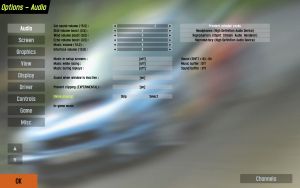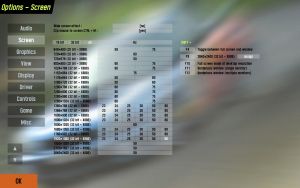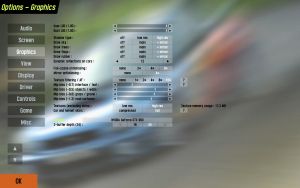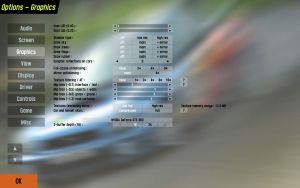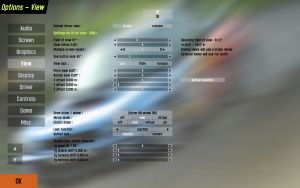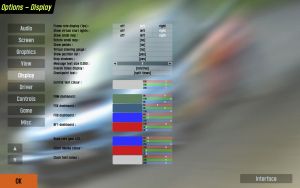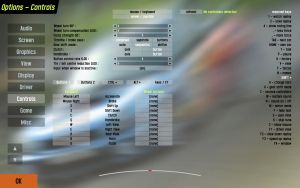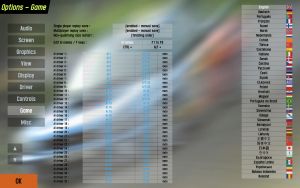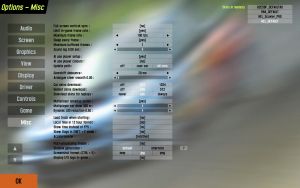オプション
Optionの項目は、新しいパッチが公開されると変更される場合があります。
Audio
このメニューによって、BGMといろいろな音量を変えることができます。
Car Sound Volume: 車の効果音(BGMとメニューの効果音に比例しています)
Skid Volume Boost: スキッド音のブースト(リアルスティックにするには「1.0」にセットして下さい)
Wind Volume Boost: 風の効果音(このセッティングに関係なく、オープンカーは風の効果音が非常に大きい点に注意してください)
Echo volume boost: エコーの効果量(デフォルト値は2.0)
Music volume: メニューとレース中のBGM
Music in setup screens: セットアップ画面のBGMのオン/オフ
Music while racing: レース中のBGMのオン/オフ
Music during replays: リプレイ中のBGMのオン/オフ
Song choice: 『Skip』と『Select』で、BGMを選択できます。
In-game music: LFSはプレイリストをサポートしています。プレイリストを使用して曲目を変更できます。
Channels: Using this button you will enter the interface for playlist creation and editing. Channel 1 is the standard for all setup screens and can not be deleted. You can add, rename and delete playlist on the left of the screen. On the right you can add tracks assign a song to each track and delete tracks. To ensure that a track will be played back you have to its priority with 3 being the highest priority, 1 the lowest priority and – the setting to prevent a track from being played. The higher the priority of a song the more likely it is that it is being played back. This means that if you have two song of the same priority you will hear both song equaly often but if the one song has a priority of 3 and the other a priority of 1 you will hear the first song much more frequently.
メモ: 音楽ファイルにはOgg Vorbisフォーマットを使用します。www.vorbis.comで利用可能なフリーウェア・エンコーダーを使用するか、その他のエンコーダーソフトで作成してください。 できたOggファイルを\Data\Oggディレクトリーに入れておいてください。
Screen
このメニューでは、解像度と色数、リフレッシュレートを選ぶことができてます。またキーボードに割り当てることも可能です。
Show non-square modes: ワイド画面など縦横比が4:3以外のディスプレイを使用するときに使われます。
Show 32.bit modes: 32ビット(約1670万色)の解像度の表示。32ビットにすると色数が増えますが、ビデオカードの性能が低ければ描画パフォーマンスが低下し、ビデオメモリの消費量も増加します。標準は16ビット(約65000色)です。
Wide screen effect: ワイドスクリーン・エフェクトの表示
Clip mouse to window: ウィンドウモードでマウスポインタが画面からはみ出ないようにします。もしマウスで車を操縦しているならば、これは重要です。Ctrl+Cでも変更できます。
Key assign: 解像度をキーボードに割り当てます。解像度と色数、リフレッシュレートをShift+F9~Shift+F12に割り当てることができます 。右側のボタンのうちの1つを選んで割り当てて下さい。
Graphics
このオプションは、グラフィックス品質の全ての秘密の握っています。このオプションを微調整することにより、フレームレートを上げたり、画質のクオリティーを改善することができます。いくつかの項目は、時代遅れのコンピューターにとって、ゲームのフィーリングを劇的に改善することができます。右の写真は最高・最低設定です。
- 『LOD(Level Of Detail)詳細レベル』とは物体とテクスチャーの品質が、距離に応じて変化する設定です。たとえば、低い詳細レベルの場合、タイヤは角張って見えます。
User LOD: 遠くに表示される物体が省略されて表示されます
- パフォーマンス: 0.25 | クオリティー: 1.00
Dust LOD: 煙と砂塵の品質
- パフォーマンス: 0.25 | クオリティー: 1.00
Mirror LOD: ミラーに写る物体の品質。『User LOD』のミラー版
- パフォーマンス: 0.25 | クオリティー: 1.00
Screen width affects LOD: 画面の解像度が『詳細レベル(LOD)』に影響するかの設定。1024x768を境にON/OFFの効果が逆になります。
- 画面解像度1024x768以下 – パフォーマンス: ON | クオリティー: OFF
- 画面解像度1024x768 – ON/OFF関係なし
- 画面解像度1024x768以上 – パフォーマンス: OFF | クオリティー: ON
Track LOD reduction: ONにするとパフォーマンスを非常に向上させることができます。いくつかの地形が距離に応じて非表示になります。画面のクオリティーにそれほどこだわらないのであれば、常にONにしておくのが良いでしょう。
- パフォーマンス: ON | クオリティー: OFF
Mip bias: ミップマップ・バイアスの調整(0.00にするほど遠くのテクスチャーにフィルターがかかります)
Shadow type: 影のタイプ
Simple wheels: シンプルホイールの設定。ホイールはポリゴン数が多いのでALL(すべて簡易表示)にするとパフォーマンスUP
Disable trees: 樹木を非表示にするかどうか(ALL=全て非表示でパフォーマンスUP)
Disable flags: 旗を非表示にするかどうか(ALL=全て非表示でパフォーマンスUP)
Disable rubber: タイヤ痕を非表示にするかどうか(ALL=全て非表示でパフォーマンスUP)
Enable dither: 色数が16ビットのとき、ディザ表示を有効にするかどうか
Enable mip fillter: ミップマップ・フィルターを使用するかどうか(要追記)
Use compressed skins: 圧縮されたスキンを使用するかどうか(要追記)
Half texture size: テクスチャーサイズを半分にします。ビデオメモリが少ない場合に限り『Yes』
ビデオカードの設定
Hardware Vertex Shading: ハードウェアでシェーディングをするかどうか
Z-Buffer Depth: Zバッファー(陰面処理)の精度
Simple Track(no car shadow): なぜか『OFF』が一番パフォーマンスあり?(要追記)
Haze effect: もや・かすみのエフェクト
View
このオプションは、視点、つまりカメラを調節します。運転しやすいようにカスタマイズすることは、ラップタイムにも影響を与えるので非常に重要です。
Field of view: カメラの視野(ズーム量)。デフォルト値は、90°辺りです。(キーボードの5、 6でも可)
以下の4つの項目は、スタンダードビューとカスタムビューの両方で、Gフォースによる頭と体の影響度を設定します。0に設定するとカメラはGフォースの影響を受けません。
1g head tilt: Gフォースによる頭の傾き量
1g lateral shift: Gフォースによる体の左右の移動量
1g forward shift: Gフォースによる体の前後の移動量
1g vertical shift: Gフォースによる体の上下の移動量
Default Driver view: In car(スタンダードビュー)と、custom(カスタムビュー)の切り替え。
- スタンダードビューは最もリアリスティックなモードで、カスタムビューは好きなところに自由に配置できます。
- カスタムビューの設定方法は、後ほど説明しましょう。
- ここで選択したモードはLFSをスタートした時に自動的に選択されます、またSHIFT + F1を押すとで切り替わります。
- あなたがよく使用するモードを選択してください。
スタンダード・ビューモード(In car)
Move view with animation: 『ON』にするとステアリングを左右に切った時に、体の軸がぶれるのをリアルに再現します。お好みで設定してください。
Pitch view: カメラの上下方向の回転量の調節
Rotate view: カメラの水平方向の回転量の調節
Mirror offsets lateral: ルームミラーの水平方向の調節
Mirror offsets vertical: ルームミラーの垂直方向の調節
Draw driver / wheel: ドライバーの両腕、ステアリングホイールを表示/非表示にします。ホイールコントローラーを使用している人々がよく非表示にしています。
Clocks mode: 計器類の表示方法。
カスタム・ビューモード(custom)
(メモ:この設定は、車種ごとに保存されます。)
Style: 表示スタイルを選びます。
- 『no draw』 何も表示しません
- 『wheels』 タイヤだけ表示
- 『external』 車両を表示
- 『ext.2』 externalと同じですが『Button look』で左右・後方を見た時、車体は表示されません。
Pitch view:
Rotate view:
Mirror offsets lateral: スタンダードビューと同じです。
Mirror offsets vertical:
Draw driver / wheel:
Clocks mode:
X offset:" 左右のカメラの位置
Y offset:" 前後のカメラの位置
Z offset:" 上下のカメラの位置
~~~
Look function: このオプションで『Button look』以外に左右を見る方法を追加できます。
- 『Axis』 Controlsメニューで軸を指定して、カメラ左右を動かせます。
- 『steer』 ステアリングを左右に切ると、それに応じてカメラも回転します。Look sensitivityで感度を調節できます。
- 『ms X』 マウスでカメラを左右を動かせます。『Look centre reduction』で移動量を調節できます。
- 『ms XY』 マウスでカメラを上下・左右を動かせます。
Button look: Controlsで指定したボタン押して左右・後方を見る時、スムーズにパンするか、一瞬でパンするか選べます。
ビューのボタンとショートカット
V : 次のカメラに変更
SHIFT + V : 前のカメラに変更
TAB : 次の車を表示
SHIFT + TAB : 前の車を表示
HOME : 自分の車を表示
SHIFT + F1 : 『Default Driver view』にカメラを変更
SHIFT + F : 全ての画面表示・メッセージを非表示
SHIFT + M : ミラーモードの変更 (ミラーなし/リアルミラー/バーチャルミラー)
SHIFT + U : AutoX エディター/フリービューモード
Display
レース画面にはさまざまな情報が表示されます。レースや車の情報、チャットの文字大きさを設定できます。
Frame rate display: フレームレートの表示位置
Digital speedo: スピードメーターをデジタル/アナログに変更
Mirrors mode: ミラーの表示方法。『real』はコックピットを表示しなければなりません。
Show pedals: ペダルバーの表示/非表示
Show small maps: コース図の表示/非表示
Drop shadows: 見やすいように、テキストに影をつけます
Message size: チャットなど左に表示されるメッセージのサイズ
Display results: 右上のリザルトの表示。CTRL+Tabでも切り換えできます
Overall times display: リザルトの他車とのタイム差の表示方法
Checkpoint text: 区間タイムの表示/非表示
Show virtual start lights: バーチャル・スタートライトの表示/非表示
Manual shift indicator: シフトライト(アップ時のみ)の表示/非表示
FOX / F08 / BF1 dashboard: フォーミュラ系の車のメーターの色を変更できます。
Interface インターフェースのボタンやテキストの、色・透明度を変更できます。
Player
ここではプレーヤーに関する設定ができます。
(メモ:この設定は、プレーヤー名ごとに保存されます。)
Player name: プレーヤー名を変更できます
Other players: 新たにプレーヤー名を作成・削除できます
Number plate: ナンバープレートの文字を変更できます
Driver position: 右ハンドル/左ハンドルを選択できます
Speed display: スピード表示の単位
Pressure display: 圧力の単位
Break help: ブレーキヘルプのOn/Off
Shift type: シフトタイプの選択
シーケンシャル、シフター選択時
Auto clutch: 自動でクラッチを切ってくれます
Throttle blip on downshift: シフトダウン時に自動でブリッピングします
Throttle cut on uphift: シフトアップ時に自動でスロットルカットします
Controls
Mouse/Keyboard
Button control rate: This is for when you assign a button to an analogue control (e.g. handbrake or clutch) how fast the control moves when the button is pressed. Higher is faster.
Keyboard steer: keyboard - no help / keyboard - stabilised / mouse steer toggle. This is how you select your input method:
Mouse steer (rather obviously) lets you use the mouse for steering and assign throttle and brake to buttons (be they on your keyboard or your mouse).
Keyboard - no help directly translates button presses into wheel movement. So long as the button is held down, the wheel will continue turning until it reaches maximum lock. There is an auto return to centre function when no steering keys are pressed. Both rates are configurable. Also, pressing both left and right will hold the wheel in its current position. This steering method is definately not recommended, since it is impractically difficult to race with.
Keyboard - stabilised has two main differences to "keyboard - no help". Firstly, it limits the movement of the wheel depending on the amount of grip the tyres have. This limit is also adjustable. Secondly it adds a small amount of automatic countersteering to help balance the car. While this is a driving aid (and the turn limit can be considered one as well), it is essential for using such a basic input device for a task it obviously would never be used to do in real life. Thankfully the keyboard steering is highly configurable in LFS so you should be able to get it to work to your preference.
Auto gear shift: Yes or No toggle. If enabled, the computer will change gear for you (and probably at the wrong time too).
Mouse steer only:
Steer centre reduction: This is a non-linearity slider and is designed to make it easier to control the car buy reducing straight line twitchyness. A setting of 0.0 gives fully linear steering whereas a setting of 1.0 gives fully non-linear steering. A setting of 0.4 to 0.6 is recommended.
Keyboard steer only:
Steer rate: The speed the wheel turns when you press the left or right steer buttons. Higher values will make the car more responsive but less stable, and vice versa.
Return rate: The speed the wheel turns when you depress the left or right steer buttons. Higher values will make the car more responsive but less stable, and vice versa. It is usual to use a lower value for the return rate, between 50 to 75% of the steer rate.
Fast steer multiplier: When holding the "Steer Fast" key, the steer rate will be temporarily increased. This slider controls by what percentage it will be increased. With the default setting of 2.00, the steer rate will be doubled. This fast steering option can be useful when quick corrections are needed, such as when countersteering. Chances are you're going to crash anyway so this option is of limited helpfulness.
Slow steer multiplier: When holding the "Steer Slow" key, the steer rate will be temporarily reduced. This slider controls by what percentage it will be reduced. With the default setting of 0.50, the steer rate will be halved. This slow steering option is most useful at higher speeds when finer control over the vehicle is needed. However the keyboard steering is automatically speed sensitive, so there is really no need to ever use this anyway.
Limit multiplier: A setting of 1.0 limits the wheel turn to that of the available grip of the tyres. Settings higher than this allow you to turn further, to induce understeer. Settings lower than 1.0 means you won't get so close to the limits of the car, so control is retained. The further you reduce this setting, the easier the car will be to drive, at the sacrifice of cornering speed. (available with Keyboard - stabilised only)
In the Buttons 1 subsection you select which button to assign to the function labelled to the right of the button. To choose and lock in your selection, simply click on the button to highlight it, a text message with instructions will appear at bottom of screen, Click desired button or key you wish to associate with this button etc. Do this for all Button 1 selections, then move on to Button 2 section using the same method to select and assign your desired keys or buttons to control the views etc.
When you have completed this, mouse users and keyboard users are finished, and may want to skip the section on wheels and joysticks. And go directly to the far right of this screen and look closely at the various key sequences and what they do. i.e. (Reserved keys) and Shift + combinations.
Wheel/Joystick
This section provides different options additional to the previous section. Existing keyboard and mouse settings can still be used just by clicking on the Mouse/KB button. This is useful if your wheel breaks or springs in pedal fall apart.
After selecting to enable your wheel you will need to set it up for maximum efficiency depending on the make and whether is has force feedback functions etc some options will not be needed or may be used if desired. Please note that you might have to change some settings in the drivers of your wheel manufacturer, e.g. to enable split axes.
Steer center reduction: Adjusts the turn ratio of the users wheel to the LFS car.
Force strength: For FF users, higher settings mean more feedback. Just try what suits best to you.
Throttle/brake axis: Can be one of three different states:
Combined: The brake and throttle use the same axis
Seperate: The brake and throttle use one axis each for their settings
Button: The brake and throttle use can be assigned to a button or a paddle
Shift type: We have discussed earlier the three types and their use.
Clutch & Handbrake: Can be assigned to any spare axis or button if you wish.
Throttle/brake centre reduction: Adjusts the sensitivity of the throttle and brake and the point at which it starts to apply.
ホイール・コントローラーのセットアップ
This is the area where wheel and joystick users get to assign the axis. Again most of these options are largely a click and set type button. Firstly please make sure your equipment is attached to the computer and windows has found the device and it has been set up in Control Panel / Game Controller area. Run your profiler software if needed and deselect combined axis at a windows level if needed. Calibrate using windows software before attempting to setup in LFS.
When you arrive at the controls screen shown above you be able to choose a range of options from those available to make your wheel or joystick work best with LFS. To select an axis click on the button lets start with Steer: Highlight steer and you will notice the panel available axis will light up from there you can choose which of the axes to use. The bar next to the axis will show you the range of motion of the mapped device and is used to calibrate. Highlight and select as many or as few as you wish.
For those with a force feedback controller you must enable the Force Feedback to allow any previous settings to take effect – when finished you will need to test that each axis is correct and not reversed as sometimes controllers are wired different to normal and your brake or accelerator may be on all the time. If you then choose recalibrate you can then turn the wheel or joystick left & right to determine the maximum limits and see if you have maximum settings on throttle etc. If the settings are indeed reversed use the invert button next to the selected device to reverse polarity. Have a play with these settings and you’ll soon get the hang of the controls.
For the steering wheel turns for each car, see this page
Game
Here we set some minor options such as the automatic/manual saving of races, the finishing order for race restarts etc - We can substitute names for the AI, maybe we want to race against Peter Brock or Michael Schumacher? Just click to cycle through the available options of each selection. The most important feature however, is the ability to add to the F1 - F8 keys of your own custom messages, such as “Sorry”, Hello, etc for use when in game and too busy to type a reply etc. To do this, select the "F1 to F8" button and in the space next to the selected key, click to open, then type in your message text, click OK to save. There is a limit on length etc, but most short messages can be written.
On the right side of this page you can select the language used in LFS.
Single player replay save: Not enabled / Enabled / Auto save. Sets how replays should be handled. Not enabled means there are no replays recorded, ever. Enabled means replays are recorded, but you have to save them manually (ingame, hit "1" to save with automatically generated name, or hit "2" to save with custom name). Automatic means that every replay is saved with an automatically generated name, without requiring you to do anything.
Multiplayer replay save: See single player replay save.
Non-qualifying race restart: Sets how race (re)starts that had no prior qualifying should be handeled. The options are self explanatory.
Edit AI names / F keys:
AI names - Self explanatory.
F1 to F8 - Click on the spaces/buttons right to the desired key to define the text to say on hitting the corresponding key. The codes in there are the same as if hitting "T" (to talk) ingame.
CTRL + - Same as behaviour as in "F1 to F8", but defines the actions when hitting CTRL plus the desired key at the same time. Additionally you have access to keys F9 - F12 here.
Misc
There are seventeen (17) different options here! Including some things that make a difference to game play and frame rates.
Full screen vertical sync: On/Off toggle
Limit frame rate in game: On/Off toggle, this is used in conjunction with the next option to set what max frame rate to use.
Maximum frame rate: Here you can set a minimum / maximum number of frames for use in game – depends upon the previous setting to enable/disable.
Minimum sleep: You select time value. This setting forces LFS to sleep/wait the set amount of time between each frame, to allow Windows to update controller inputs, etc. Increase this value if you're having problems with controller stuttering/lag or similar. Don't put it too high, though, as it will limit your maximum framerate.
Screen clear type: Ellipsoid and Clr+Sky are the same quality but just drawn in a different way to allow for what’s best with different cards. Usually it makes no difference but choose the one which gives the better frame rate. Plain draws no sky, which can increase your framerate on older systems.
Log messages: On/Off toggle - this option will keep a log of all the text chatter between players.
AI use player setup: Self Explanatory
AI use player colours: Self Explanatory
Sound lag: Because the program has to play the sound slightly in advance, so that there are no gaps in the sound. Recommended setting is as low as possible without hearing stutters or gaps in the sound.
Analogue steer smooth: Sets the amount of smoothing for joysticks and some wheels. The higher the value, the smoother your inputs will be, but they will also lag behind slightly.
Multiplayer speedup option: This options makes the distant cars use less cpu by not updating their physics or drawing them at all. It’s disabled when you view from the TV cameras because frame rate isn’t so important then..
Multiplayer car draw: Only visible when the above option is enabled. Sets the distance the cars are drawn. Use a lower value for increased framerates.
Dynamic LOD reduction: Sets the value for the dynamic change of "Level of Detail". Zero means no, and one is full dynamic LOD reduction. This makes the Level of Detail change dynamically depending on how many cars are visible and on your current framerate. Use higher values if you experience slowdowns when multiple cars are visible.
Update path: 3 options – Off, User car or All cars - This determines which cars update the rubber mark on the track - the racing line rubber.
Load track when starting: Yes/No toggle. If disabled, the startup time of LFS will be considerably decreased.
Local time in 12 hour format: Self Explanatory
Show time instead of FPS: Yes/No toggle. If on, the FPS display (see Options - Display) will be replaced with the local time.
